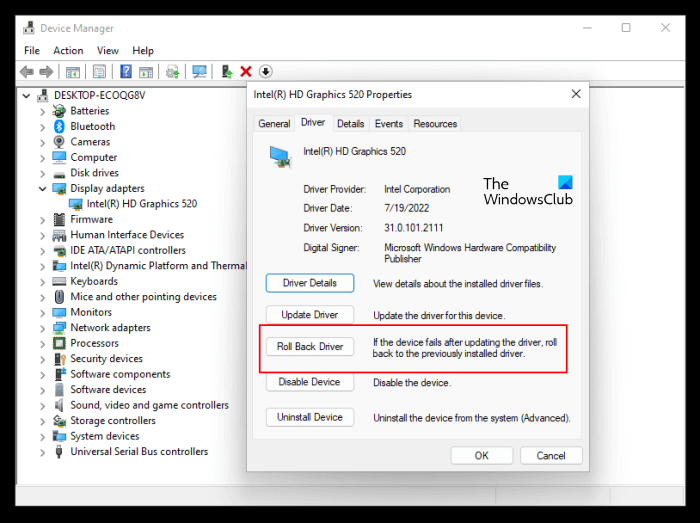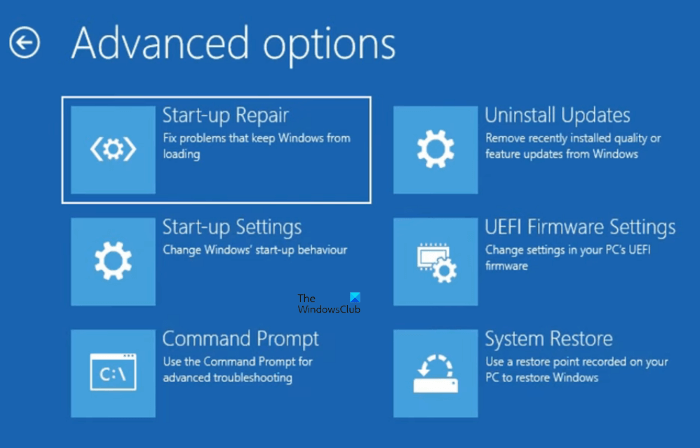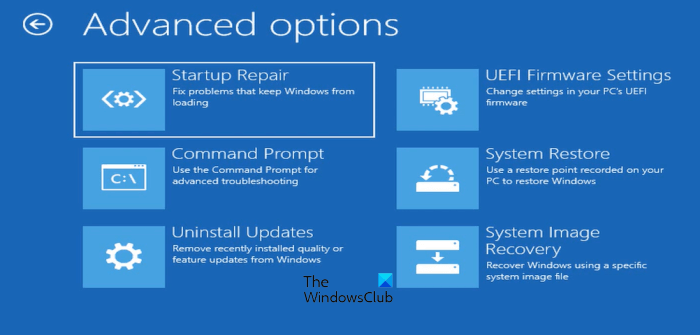This article lists some solutions to fix amdkmpfd.sys failed Blue Screen on Windows 11/10. This is a Blue Screen of Death error that occurs on computer systems with AMD graphics cards. The file amdkmpfd.sys, is part of the AMD graphics card device driver on your system According to the affected users, this error occurred after installing a Windows Update or after updating their graphics card driver. If your computer system has an AMD graphics card, you may encounter this BSOD error.

The complete error message is as follows:
Stop code: DRIVER IRQL NOT LESS OR EQUAL
What failed: amdkmpfd.sys
Fix amdkmpfd.sys failed Blue Screen on Windows 11/10
If you see the amdkmpfd.sys failed Blue Screen on Windows 11/10 computer, the following fixes will help you get rid of the problem.
- Update Graphics Driver
- Roll back your graphics card driver
- Uninstall and reinstall your graphics card driver
- Check the cable connecting your graphics card driver to your system
- Run SFC and DISM scans in Windows RE
- Turn off Fast Startup
- Turn off the Switchable Graphics option in BIOS (if applicable)
- Uninstall the latest Windows Update.
Let’s see all these fixes in detail.
1] Update Graphics Driver
If you haven’t updated your driver, then we suggest you first update your Graphics Driver and see if it helps.
2] Roll back your graphics card driver
According to some users, the issue occurred after updating the graphics card driver. If such a thing happened to you, we suggest you roll back your graphics card driver. To do so, you have to boot into Safe Mode. If you are unable to log in to your system, you can enter Safe Mode via Windows Recovery Environment.

After entering Windows RE, go to the Advanced options screen and click on the Start-up Settings option. After that, click Restart and then press the required Function key to enter Safe Mode with Networking. After entering Safe Mode, open the Device Manager and roll back your graphics card driver. When you are done, exit Safe Mode and restart your computer.
3] Uninstall and reinstall your graphics card driver
If rolling back your graphics driver did not help, uninstalling and reinstalling it will help. Enter Windows Safe Mode with Networking and download DDU (Display Driver Installer) from the internet. Now, use DDU to completely remove or uninstall your AMD graphics card driver. Do note that in Safe Mode, some drivers remain disabled. Hence, you will not be able to connect to the internet via Wi-Fi. Hence, you have to use the Ethernet cable to surf the internet in Safe Mode with Networking.
After uninstalling the graphics card driver, exit Safe Mode and restart your computer. On normal startup, Windows will look for missing drivers and install them automatically. This should fix the problem.
4] Check the cable connecting your graphics card driver to your system
If you use an external graphics card to play video games on your PC, this may be the cause of the Blue Screen error. Make sure that the cables connecting your graphics card to your system are not loose. In addition to this, faulty cables can also trigger BSOD errors like this one.
5] Run SFC and DISM scans in Windows RE

There are many causes of a BSOD error. One of these possible causes is the corrupted system image files. We suggest you repair your system files and see if it helps. Since the BSOD error is preventing you from logging in to your computer, you have to run the SFC and DISM scans in the Windows Recovery Environment.
To enter Windows Recovery Environment, turn off your computer, then press and hold the Shift key and turn on your computer. If this method does not work, use the following steps:
- Press and hold the power button to shut down your computer.
- Press the power button to turn on your computer.
- When your computer manufacturer’s logo or Windows logo appears on your screen, immediately press and hold the power button to turn your computer off.
Repeat the above steps until you see the Automatic Repair screen. Now, on the Automatic Repair screen, click “Advanced options > Troubleshoot > Advanced options > Command Prompt.”
When the Command Prompt appears on your screen, you will see:
x:\windows\system32>
Select the hard drive on which the Windows operating system is installed. In most cases, Windows is installed on the C drive. Hence, type the following command and hit Enter.
C:
If Windows is installed on another drive, type that drive letter in the above command. Now, run SFC and DISM scans one by one. After the scans get completed, close Command Prompt and click Continue to start your computer. See if the issue occurs. If the error persists, use the other solutions.
6] Turn off Fast Startup
If the above fixes resolved your issue, we suggest you turn off Fast Startup (if it is enabled on your device). Fast Startup enables your computer to start faster. Hence, it is a useful feature, but sometimes it causes problems on a Windows computer. According to the feedback of some affected users, the amdkmpfd.sys failed Blue Screen error can occur again if Fast Startup is enabled on Windows 11/10. That’s why we suggested you disable Fast Startup on your system.
7] Turn off the Switchable Graphics option in BIOS (if applicable)
If your system has multiple graphics cards, you will find the Switchable Graphics option in BIOS. If the problem still persists and you are unable to view the login screen, we suggest you turn off Switchable Graphics and select the Integrated Graphics option in BIOS. After signing in to your computer, you can uninstall and reinstall the AMD graphics card driver.
Some users downloaded and installed the older version of their AMD graphics card driver (as per their GPU model name). If you can manage to download the older version of your graphics card driver, install it.
8] Uninstall the latest Windows Update

If the issue occurs after installing the latest Windows Update, uninstalling that particular update will fix the problem. To do so, you have to enter Windows Recovery Environment. After booting your system in Windows Recovery Environment, go to the Advanced options screen and click on the Uninstall Updates option. After that, select the latest quality or feature update to uninstall it.
Can outdated drivers cause Blue Screen?
Outdated or corrupted device drivers can sometimes cause Blue Screen errors on a Windows 11/10 computer. Apart from this, hardware issues are also responsible for BSOD errors. When a BSOD occurs on a Windows computer, Windows creates its log. You can view the BSOD logs in Windows Event Viewer.
How do I fix BSOD on Windows 11/10?
A BSOD error can occur due to several causes. Both hardware and software issues can cause BSOD errors on Windows 11/10. When you see the BSOD error, you can use some common fixes, uninstalling the recently installed software, uninstalling the recent Windows Updates, repairing your system image files, etc.
I hope this helps.
Read next: DRIVER IRQL NOT LESS OR EQUAL (kbdclass.sys) BSOD error on Windows 11/10.